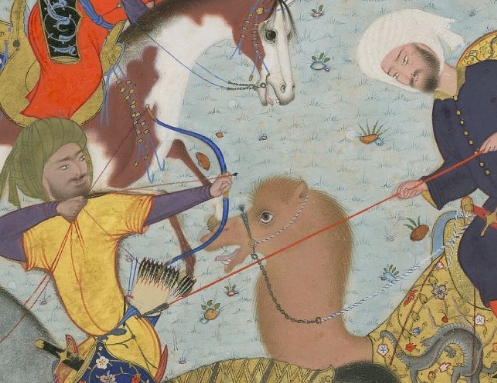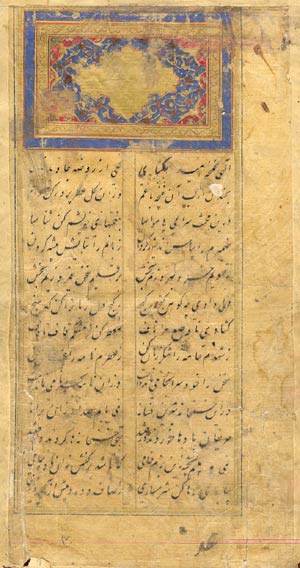Haft Aurang on:
[Wikipedia]
[Google]
[Amazon]



 ''Haft Awrang'' ( fa, هفت اورنگ, meaning "Seven Thrones") by the
''Haft Awrang'' ( fa, هفت اورنگ, meaning "Seven Thrones") by the
Explore the Freer Jami
15th-century books Persian poems Persian words and phrases



 ''Haft Awrang'' ( fa, هفت اورنگ, meaning "Seven Thrones") by the
''Haft Awrang'' ( fa, هفت اورنگ, meaning "Seven Thrones") by the Persian
Persian may refer to:
* People and things from Iran, historically called ''Persia'' in the English language
** Persians, the majority ethnic group in Iran, not to be conflated with the Iranic peoples
** Persian language, an Iranian language of the ...
poet Jami
Nūr ad-Dīn 'Abd ar-Rahmān Jāmī ( fa, نورالدین عبدالرحمن جامی; 7 November 1414 – 9 November 1492), also known as Mawlanā Nūr al-Dīn 'Abd al-Rahmān or Abd-Al-Rahmān Nur-Al-Din Muhammad Dashti, or simply as J ...
is a classic of Persian literature
Persian literature ( fa, ادبیات فارسی, Adabiyâte fârsi, ) comprises oral compositions and written texts in the Persian language and is one of the world's oldest literatures. It spans over two-and-a-half millennia. Its sources h ...
composed some time between 1468 and 1485. Jami completed the work as seven books following a masnavi
The ''Masnavi'', or ''Masnavi-ye-Ma'navi'' ( fa, مثنوی معنوی), also written ''Mathnawi'', or ''Mathnavi'', is an extensive poem written in Persian by Jalal al-Din Muhammad Balkhi, also known as Rumi. The ''Masnavi'' is one of the most ...
format:
* "Selselat adh-dhahab" (, "Chain of Gold"): a collection of didactic anecdotes
* "Yusof-o Zulaikhā" (, " Joseph and Zulaikha"): the romance of Joseph
Joseph is a common male given name, derived from the Hebrew Yosef (יוֹסֵף). "Joseph" is used, along with "Josef", mostly in English, French and partially German languages. This spelling is also found as a variant in the languages of the mo ...
and Zulaikha, wife of Potiphar
Potiphar ( ; Egyptian origin: ''pꜣ-dj-pꜣ-rꜥ'' "he whom Ra gave") is a figure in the Hebrew Bible and the Quran. Potiphar is possibly the same name as Potiphera () from Late Egyptian ''pꜣ-dj-pꜣ-rꜥ'' "he whom Ra has given."
Potiphar ...
based on the Islamic traditions.
* "Sabhat al-abrār" (, "Rosary of the Pious"): another collection of didactic anecdotes
* "Salaman-o Absāl" (, Salaman and Absal): A doomed romance between a prince and his nursemaid. The original story is Greek, translated in the early Islamic times to Arabic by Ibn Hunain and then rendered into Persian poem by Jami. Dehkhoda
Allameh Ali Akbar Dehkhodā ( fa, علیاکبر دهخدا; 1879–March 9, 1956) was a prominent Iranian linguist and lexicographer. He was the author of the Dehkhoda Dictionary, the most extensive dictionary of the Persian language pu ...
suggests this story might have an Israelite origin.
* "Tohfat ol-ahrār (, "Gift of the Free")
* "Layli-o Majnun" (, "Layla and Majnun
''Layla & Majnun'' ( ar, مجنون ليلى ; Layla's Mad Lover) is an old story of Arab origin, about the 7th-century Bedouin poet Qays ibn al-Mulawwah and his ladylove Layla bint Mahdi (later known as Layla al-Aamiriya).
"The Layla ...
")
* "Kheradnāma-i Eskandari" (, "Alexander's Book of Wisdom") account of events leading up to Alexander's death.
The term Haft Awrang itself is a reference to the seven stars that form the Big Dipper
The Big Dipper ( US, Canada) or the Plough ( UK, Ireland) is a large asterism consisting of seven bright stars of the constellation Ursa Major; six of them are of second magnitude and one, Megrez (δ), of third magnitude. Four define a "bowl" ...
(the Plough or ).
Religion, philosophy, and ethics of Sufi
Sufism ( ar, ''aṣ-ṣūfiyya''), also known as Tasawwuf ( ''at-taṣawwuf''), is a mystic body of religious practice, found mainly within Sunni Islam but also within Shia Islam, which is characterized by a focus on Islamic spirituality, ...
origin lie at the root of all seven masnavis.
Freer Jami
Between 1556 and 1565, while he was governingMashad
Mashhad ( fa, مشهد, Mašhad ), also spelled Mashad, is the second-most-populous city in Iran, located in the relatively remote north-east of the country about from Tehran. It serves as the capital of Razavi Khorasan Province and has a po ...
, Prince Sultan Ibrahim Mirza
Prince Ibrahim Mirza, Solṭān Ebrāhīm Mīrzā, in full Abu'l Fat'h Sultan Ibrahim Mirza ( fa, ابوالفتح سلطان ابراهیم میرزا) (April 1540 – 23 February 1577) was a Persian prince of the Safavid dynasty, who was a favo ...
, nephew and son-in-law of Shah Tahmasp I
Tahmasp I ( fa, طهماسب, translit=Ṭahmāsb or ; 22 February 1514 – 14 May 1576) was the second shah of Safavid Iran from 1524 to 1576. He was the eldest son of Ismail I and his principal consort, Tajlu Khanum. Ascending the throne after t ...
, commissioned his own atelier of painters and calligraphers to create a sumptuous illustrated version of the Haft Awrang, producing one of the undoubted masterpieces of the Persian miniature
A Persian miniature (Persian: نگارگری ایرانی ''negârgari Irâni'') is a small Persian painting on paper, whether a book illustration or a separate work of art intended to be kept in an album of such works called a ''muraqqa''. The ...
, now in the Freer Gallery of Art
The Freer Gallery of Art is an art museum of the Smithsonian Institution in Washington, D.C. focusing on Asian art. The Freer and the Arthur M. Sackler Gallery together form the National Museum of Asian Art in the United States. The Freer and Sac ...
, and known as the Freer Jami.
References
* hardback: {{ISBN, 978-0-300-06802-3External links
Explore the Freer Jami
15th-century books Persian poems Persian words and phrases